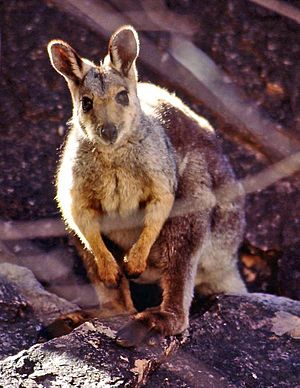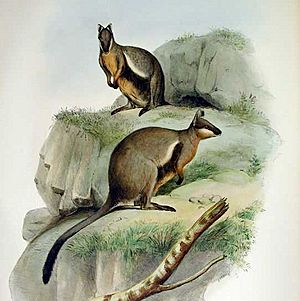Black-flanked rock-wallaby facts for kids
Quick facts for kids Black-flanked rock-wallaby |
|
|---|---|
 |
|
| Conservation status | |
| Scientific classification | |
| Genus: |
Petrogale
|
| Species: |
lateralis
|
 |
|
| Black-flanked rock-wallaby range (blue — native, pink — reintroduced) |
|
The black-flanked rock-wallaby (Petrogale lateralis), also called the black-footed rock-wallaby or warru, is a special type of wallaby. It's one of many rock-wallabies found in the Petrogale group. These wallabies are known for living in rocky areas.
Contents
About the Black-Flanked Rock-Wallaby
The black-flanked rock-wallaby is a shy animal. It has black and grey fur. This helps it blend in with its rocky home. Its fur gets lighter in color during summer. It has short, thick, and woolly fur. This fur is extra dense around its tail, bottom, and sides.
Its long, bushy tail is very helpful. It helps the wallaby keep its balance. This is important when it hops from one rock to another. The bottom of its feet are also very bumpy. This stops it from slipping on the rocks.
What They Look Like
This small wallaby is mostly greyish-brown. It has a lighter belly and chest. A dark stripe runs from its head down its back. Its tail and feet are also dark.
Where and How They Live
These wallabies live in groups. A group can have from 10 to 100 wallabies. They are nocturnal, meaning they are active at night. They usually look for food in open grassy areas. They eat fruit, leaves, and different kinds of plants.
Most of their water comes from the food they eat. So, they rarely need to drink water. They can save water by hiding in rocky caves. This keeps them cool from the heat. They are most active when they leave their shelters in the early evening.
Wallaby Babies
Wallabies become adults at 1 to 2 years old. After that, they can have babies all year. This depends on how much rain there is. Female wallabies can pause their pregnancy. This is called embryonic diapause. It means the baby's growth can stop for a while. It only starts again when the conditions are better.
The baby wallaby grows for about 30 days. Like other marsupials, the babies are born very tiny. They then stay inside their mother's pouch. They drink milk there until they are ready to come out. Unlike other kangaroos and wallabies, mothers leave their young in a safe spot while they go find food.
Different Types of Rock-Wallabies
The black-flanked rock-wallaby was first described in 1842. This was done by a person named John Gould. There are at least two main types, or subspecies, of this wallaby.
- Recherche rock-wallaby Petrogale lateralis hacketti
- Pearson Island rock-wallaby Petrogale lateralis pearsoni
There was another type called Petrogale lateralis purpureicollis. But now, scientists think it's a completely different species. Wallabies from the MacDonnell Ranges and the Western Kimberley are also special. They are different enough to be their own subspecies. These groups are different in their chromosomes and how they look.
Protecting the Black-Flanked Rock-Wallaby
The Australian government says the black-flanked rock-wallaby is "Vulnerable". This means it needs help to survive. They live in different places in Western Australia. The type found at the Recherche Archipelago was also listed as vulnerable in 2006.
In 2007, there were only about 50 wallabies left in the wild in South Australia. So, 15 wallabies were moved to Monarto Zoo. This zoo helps breed animals that are in danger. These wallabies came from the Pukatja/Ernabella area. They also came from another secret spot in the Anangu Pitjantjatjara Yankunytjatjara (APY) Lands.
People are working to track these wallabies. Aboriginal trackers and schoolchildren from Pukatja are helping. They follow the wallabies' movements to learn more.
Why They Are in Danger
The warru used to be found all over central Australia. But now, it's South Australia's most endangered mammal. This is mainly because of foxes and feral cats. These animals hunt the wallabies. Also, sheep, goats, and rabbits damage their homes. Changes in how fires are managed also hurt them.
Helping Them Recover
Good news! Monarto Zoo has had success breeding these wallabies. They helped create a healthy group of 22 wallabies. These wallabies live in a fenced area called Pintji. This area is about 1 square kilometer (0.4 square miles) in the APY lands.
In June 2017, 25 wallabies from Pintji were set free. Also, 15 other wallabies were released. These wallabies will be watched closely. There are also plans to control the number of foxes and feral cats. This helps keep the wallabies safe.
See also
 In Spanish: Walabí de las rocas de flancos negros para niños
In Spanish: Walabí de las rocas de flancos negros para niños



